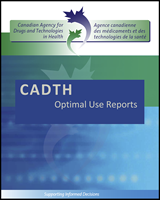Except where otherwise noted, this work is distributed under the terms of a Creative Commons Attribution-NonCommercial-NoDerivatives 4.0 International licence (CC BY-NC-ND), a copy of which is available at http://creativecommons.org/licenses/by-nc-nd/4.0/
NCBI Bookshelf. A service of the National Library of Medicine, National Institutes of Health.
Warfarin Management in Patients with Atrial Fibrillation — Current Practice Study [Internet]. Ottawa (ON): Canadian Agency for Drugs and Technologies in Health; 2012 Mar. (CADTH Optimal Use Report, No. 1.2D.)

Warfarin Management in Patients with Atrial Fibrillation — Current Practice Study [Internet].
Show detailsThe DPAC and its working groups, the OUWG and the FWG, have identified warfarin management for prevention of thromboembolic events in patients with atrial fibrillation (AF) as being a priority topic for optimal practice initiatives based on the following criteria:
- large deviations from optimal utilization (overuse or underuse)
- size of patient populations
- impact on health outcomes and cost-effectiveness
- benefit to multiple jurisdictions
- measurable outcomes
- potential to effect change in prescribing and use.
3.1. Atrial Fibrillation
Atrial fibrillation is the most common type of cardiac arrhythmia.1 It has been estimated that 200,000 to 250,000 Canadians have AF.2 This condition is associated with significant morbidity and mortality. Approximately 15% of all strokes are associated with AF; risk is strongly correlated with age, increasing from 6.7% of all strokes in patients aged 50 to 59 years to 36.2% of all strokes for patients aged 80 to 89 years.3
3.2. Technology Description
3.2.1. Vitamin K antagonist anticoagulants
Warfarin is part of the coumarin class of Vitamin K antagonists (Table 1). Vitamin K antagonists have been the mainstay of oral anticoagulant therapy for more than 60 years. Their effectiveness has been established by well-designed clinical trials for several thromboembolic indications.4 Evidence from several randomized controlled trials (RCTs) shows that long-term anticoagulation therapy with warfarin reduces the risk of ischemic stroke by 68% in patients with non-valvular AF (NVAF).3
Table 1
Vitamin K Antagonists Available in Canada.
However, clinical use of Vitamin K antagonists requires vigilance because:
- they have complex pharmacokinetics and pharmacodynamics
- they have a narrow therapeutic window
- they require (and benefit from) regular laboratory monitoring through a standardized blood test [International Normalized Ratio (INR)]
- the dose response varies among patients
- they are subject to several drug and dietary interactions.4
3.2.2. Vitamin K antagonist anticoagulant management models
The effectiveness and safety of warfarin therapy depend on maintaining the INR in the optimal therapeutic range4 (between 2 and 3 for AF6). There is a relationship between the time in therapeutic INR range (TTR) and bleeding or thromboembolic events.4 The percentage of TTR is used as a marker for the quality of warfarin management. Evidence (from international clinical trials and observational studies on cardiac and other indications) demonstrated a wide spectrum of TTRs, varying from a lower range of 32% to 68% for usual care, to a higher 55% to 92% range for patient self-management (PSM).4
Usual care is defined as warfarin dose adjustment, managed by a physician working in a private practice setting, that not only addresses anticoagulation management, but also other medical problems.7 Physicians in this setting use their own judgment, without access to specialized anticoagulation tools or anticoagulation clinic staff and services.7, 8
Approaches suggested by the literature4 to improve anticoagulant therapy include:
- anticoagulant monitoring services
- the use of point-of-care (POC) INR testing that allows patient self-testing (PST) or PSM of dose adjustment (combines self-testing with patient adjustment of their own doses)
- specialized tools to guide warfarin dose adjustment.
Anticoagulation monitoring services include a number of alternatives to usual care, from tertiary or community hospital-based anticoagulation clinics to primary-care settings and POC testing and dose adjustment by community pharmacies.9 Primary-care settings and hospital-based anticoagulation clinics may use computerized decision–support applications or other tools to guide warfarin dosing.4, 9 The primary-care anticoagulation setting involves a family practice group or family health team where nurses, pharmacists, or physicians are responsible for managing warfarin therapy.9 Specialized anticoagulation tools refer to a broad range of products that can be used by clinicians to guide dosing of warfarin in their particular practice setting. These vary from a simple web-based or paper nomogram (e.g., University of Wisconsin dosing protocol10) to an online warfarin dose calculator (e.g., WarfarinDosing.org11) to a computer application (e.g., DAWN software12).
- ISSUE - Warfarin Management in Patients with Atrial Fibrillation — Current Pract...ISSUE - Warfarin Management in Patients with Atrial Fibrillation — Current Practice Study
- Patient Experiences — Balance of Factors That Encourage or Discourage Participat...Patient Experiences — Balance of Factors That Encourage or Discourage Participation in Cervical Cancer Screening - HPV Testing for Primary Cervical Cancer Screening: A Health Technology Assessment
- Factors and Themes — Patients’ Perspectives and Experiences Review - HPV Testing...Factors and Themes — Patients’ Perspectives and Experiences Review - HPV Testing for Primary Cervical Cancer Screening: A Health Technology Assessment
- cyclin-dependent kinase 12 isoform X5 [Mus musculus]cyclin-dependent kinase 12 isoform X5 [Mus musculus]gi|1907082950|ref|XP_036012846.1|Protein
Your browsing activity is empty.
Activity recording is turned off.
See more...